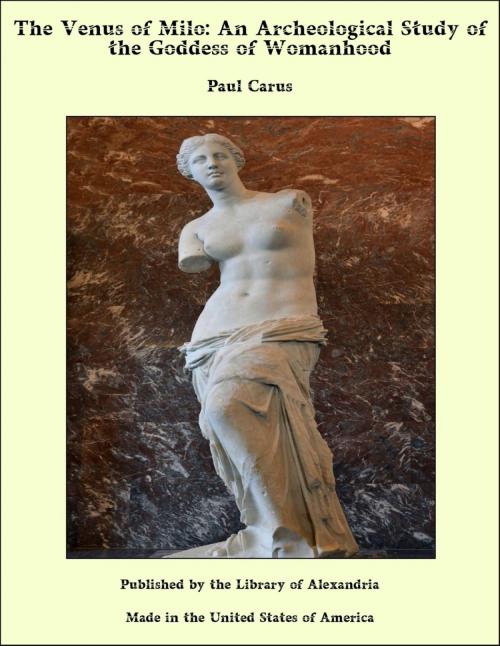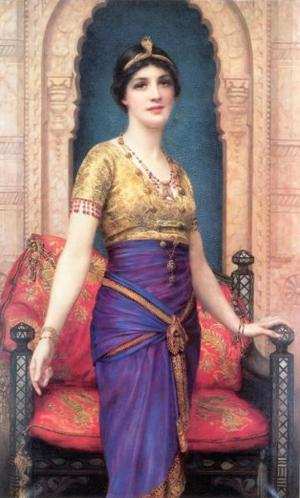The Venus of Milo: An Archeological Study of the Goddess of Womanhood
Nonfiction, Religion & Spirituality, New Age, History, Fiction & Literature| Author: | Paul Carus | ISBN: | 9781465619501 |
| Publisher: | Library of Alexandria | Publication: | March 8, 2015 |
| Imprint: | Language: | English |
| Author: | Paul Carus |
| ISBN: | 9781465619501 |
| Publisher: | Library of Alexandria |
| Publication: | March 8, 2015 |
| Imprint: | |
| Language: | English |
On this island of Melos, a peasant by the name of Yorgos Bottonis and his son Antonio, while clearing away the stones near the ruins of an ancient theater in the vicinity of Castro, the capital of the island, came accidentally across a small underground cave, carefully covered with a heavy slab and concealed, which contained a fine marble statue in two pieces, together with several other marble fragments. This happened in February, 1820. The Rev. Oiconomos, the village priest who guided the finder in this matter, invited M. Louis Brest, the French consul of Melos, to see the statue and offered it to him (in March of the same year) for 20,000 francs. M. Brest does not seem to have been in a hurry to buy, but he claims to have written to the French minister at Constantinople. One thing is sure, no answer had come by April when His French Majesty’s good ship “Chevrette” happened to cast anchor in the harbor at Melos and an ensign on board, Monsieur Dumont d’Urville, went to see the statue. The inability to sell it had brought the price down, and the finder was willing to part with it to the young Frenchman for only 1200 francs. M. d’Urville was more energetic than M. Brest and as soon as he reached Constantinople the French Minister at once authorized a certain Count Marcellus, a member of the French embassy, to go to Melos and procure the statue. Count Marcellus arrived on the French vessel “Estafette” in May, but found that the statue in the meantime had been sold to a certain Nikolai Morusi for 4800 francs and had just been placed aboard a little brig bound for Constantinople, the home of the buyer. At this juncture the three Frenchmen, M. Brest, M. d’Urville and Count Marcellus, decided not to let their treasure so easily escape them, so M. Brest protested before the Turkish authorities that the bargain had been concluded, declaring that Bottonis had no right to sell his prize to any other party. They even threatened to use force and, being backed by the French mariners of the “Estafette,” said that under no conditions would they allow the statue to leave the harbor.
On this island of Melos, a peasant by the name of Yorgos Bottonis and his son Antonio, while clearing away the stones near the ruins of an ancient theater in the vicinity of Castro, the capital of the island, came accidentally across a small underground cave, carefully covered with a heavy slab and concealed, which contained a fine marble statue in two pieces, together with several other marble fragments. This happened in February, 1820. The Rev. Oiconomos, the village priest who guided the finder in this matter, invited M. Louis Brest, the French consul of Melos, to see the statue and offered it to him (in March of the same year) for 20,000 francs. M. Brest does not seem to have been in a hurry to buy, but he claims to have written to the French minister at Constantinople. One thing is sure, no answer had come by April when His French Majesty’s good ship “Chevrette” happened to cast anchor in the harbor at Melos and an ensign on board, Monsieur Dumont d’Urville, went to see the statue. The inability to sell it had brought the price down, and the finder was willing to part with it to the young Frenchman for only 1200 francs. M. d’Urville was more energetic than M. Brest and as soon as he reached Constantinople the French Minister at once authorized a certain Count Marcellus, a member of the French embassy, to go to Melos and procure the statue. Count Marcellus arrived on the French vessel “Estafette” in May, but found that the statue in the meantime had been sold to a certain Nikolai Morusi for 4800 francs and had just been placed aboard a little brig bound for Constantinople, the home of the buyer. At this juncture the three Frenchmen, M. Brest, M. d’Urville and Count Marcellus, decided not to let their treasure so easily escape them, so M. Brest protested before the Turkish authorities that the bargain had been concluded, declaring that Bottonis had no right to sell his prize to any other party. They even threatened to use force and, being backed by the French mariners of the “Estafette,” said that under no conditions would they allow the statue to leave the harbor.















